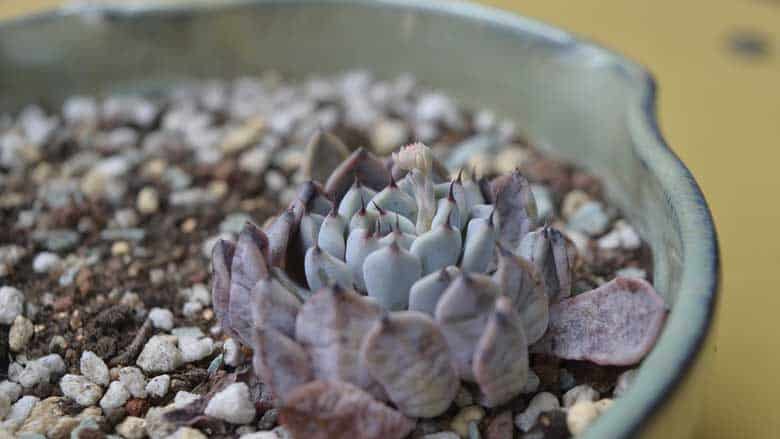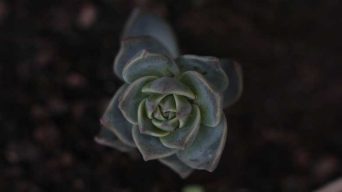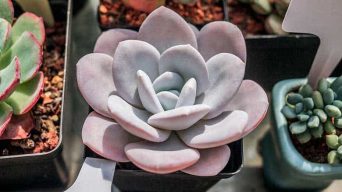Underwatering succulents can lead to root damage, wilting, and stunted growth. Signs include drooping or yellowing leaves, dry soil, and dried-out roots. To save an underwatered succulent, repot, remove damaged roots, and water thoroughly. Prevent underwatering by watering when the top soil is dry and using room temperature water.
Succulents are one of the easiest plants to grow and maintain. With the right amount of sun, water, and nutrients, succulents are likely to survive on their own.
However, one key factor that can cause most people’s problems with growing succulents: underwatered succulents.
It’s important for anyone who wants to grow or maintain a healthy succulent plant they already have to know the signs of underwatered succulents.
Underwatered succulents are common in many homes and gardens because it’s easy for people to forget about watering their plants or think they don’t need water.
In this article, we’ll discuss what an underwatered succulent is, how to identify it, the most effective treatments for plants with this condition, and how to prevent it from happening again!
What Are the Risks of Underwatering a Succulent
Although an overwatered succulent is certainly a problem, an underwatered succulent is equally as dangerous.
Underwatering can cause irreversible damage to your plant, and in worst-case scenarios, it could lead to death.
There are several risks associated with underwatering a succulent.
- If your plant is not watered enough, the roots may die, killing the entire plant.
- If your plant is not watered enough, the leaves may wilt, and it will cause irreversible damage to the succulent.
- The growth of mold or bacteria could harm your succulents if left underwater for an extended period. These harsh chemicals can burn the roots, leading to an infection that spreads into other plant areas.
- It can also lead to pests such as fungus gnats who lay their eggs on the moist substrate, which creates a perfect environment for them to thrive. The adults feed on tender root hairs and leaves of seedlings, and they carry diseases that could spread throughout your collection.
- Underwatering slows down photosynthesis; this means that if you keep an underwatered succulent indoors, then its growth cycle will slow right down, and it won’t grow as much as it should!
- Underwatering can cause stunted growth, which will create an abnormal-looking succulent. Although it may not affect your plant’s health too much, people often buy these plants because they are unusual and cute!
- Underwatering can lead to root rot which spreads quickly into the entire plant and causes it to wilt, rot, or go brown.
How Does Underwatering a Succulent Occur
If your succulent is not receiving enough water, it will begin to show signs of underwatering.
It may be dehydrated or underwatered, depending on the severity of its condition.
Underwatering occurs when the plant’s roots are deprived of adequate moisture for an extended period which can cause root rot and death if left untreated.
Underwatering is more likely to occur when the plant’s soil dries out faster than it can absorb moisture.
Let’s look at some of the most common causes of underwatered succulents:
Inadequate Watering
Succulents require thorough watering. If the succulent soil is not completely soaked and wet, you may unintentionally be underwatering it.
When water comes into contact with dry soil, its absorption rate decreases by up to 75%, so make sure that your succulent pot has a drainage hole and proper drainage in place to avoid this problem.
Also, consider where you are placing your potted plants- if they receive direct sunlight, they need more frequent watering than those out of direct light or heat, as well as rainwater which provides natural fertilizer for healthy plant growth!
Wrong Soil Type & Drainage Issues
You can also experience underwatered succulents when you use a soil mix that does not drain well.
Succulents prefer a sandy, porous and free-draining soil, which allows water to quickly pass through the pot and into the roots, where they can absorb it for nourishment.
If you’ve already used this type of soil, but your succulent still appears wilted after watering, then consider using another potting soil such as cactus mix or an aggregate like pebbles mixed with composted bark mulch instead.
These types of soils also allow air pockets between particles, so oxygen reaches their root zone more easily than heavy clay soils do while providing excellent drainage, too.
Temperature Change
Sudden temperature changes can cause your succulent leaves to wilt even when they are thoroughly watered because sudden change triggers dehydration stress.
This occurs especially for those who live in colder climates during the winter season, where temperatures drop substantially overnight.
This causes condensation within the air and on surfaces such as windowsills and walls where indoor plants reside. This leads to excessive moisture loss, which results in dryer air around houseplants than outside!
Repotting & Transplanting
Anytime you repot or transplant your succulent, it will experience shock, which will cause it to wilt and appear underwatered for a few days.
This allows the plant to focus on establishing new roots instead of growing its leaves.
The best way to avoid this is by watering succulents thoroughly the day before you plan on repotting it.
Be careful when watering your succulents after repotting, too, as you will need to wait for its soil to dry out first before watering it again.
Watering your succulents too soon after repotting will cause water to collect around the base of its stem, which can lead to root rot and potentially kill the plant!
Disease & Nutrient Deficiency
Finally, diseases or nutrient deficiencies can cause your succulent to become underwatered, especially when you notice its leaves becoming yellowish, brown, or wilted.
When the roots cannot absorb water properly, they cannot deliver water or nutrients to the plant, which leads to its wilted appearance.
To combat this, look for a potting mix with good drainage and use natural fertilizer from time to time, especially if you don’t have access to rainwater.
For succulents planted in the ground, make sure they receive enough sunlight and water, depending on their location!
Insect Damage
Insects and other pests can also cause damage to your succulents – particularly when they are underwatered.
This is because insects feed on dry plants, which means that if there isn’t enough water for the plant, it becomes an easy target!
You need to catch these problems early as well before any disease or nutrient deficiency sets in so you can save your succulent!
How To Tell If Your Succulent Is Underwatered
As long as you’re observant and take the time to care for your succulents properly, then it will be easy to tell if they are being underwatered.
It is important to know what to look for when you’re trying to determine if your plants are underwatered because otherwise, it’s easy to miss the signs of an underwatered succulent.
Signs of an Underwatered Succulent
To determine if your plants are underwatered, you need to look for certain signs. You should be able to determine if your succulents are underwatered by looking for:
Drooping Leaves
If your succulent has drooping or sagging leaves, it’s often a sign that they’re not getting enough water to drink.
This is especially likely if there are other indications present as well, such as root rot.
Note that this isn’t the only sign of underwatered succulents, and in fact, drooping can be a symptom of many different problems, not just an underwatered plant.
Yellow or Brown Leaves
Another sign of an underwatered succulent are yellow or brown leaves, particularly on new growth or young plants.
If your succulents are underwatered, the new growth will often be discolored and look unhealthy compared to healthy leaves.
This is another sign that’s easy to miss if you’re not actively looking for it.
Smaller Leaves or Stunted Growth
If your plant isn’t getting enough water, its growth can slow down significantly even though it doesn’t show any other signs of being underwatered.
If this happens, the small leaves it produces may also be smaller than usual (this effect usually only appears on younger plants).
Note that like drooping, however, stunted growth can occur due to other factors, so while this is a good indicator of an underwatered plant in general, there are still exceptions where healthy succulent plants will grow slowly.
Soft or Soggy Roots
If your plant is not getting enough water, then the roots will become dry and soggy.
If this happens to you, do not try watering it in any way until they have dried out a bit, at least.
However, even if their root system appears healthy when wet, there’s still a good chance that it is being underwatered, so don’t assume you can start watering them again just because the soil looks okay from outside of the pot either!
Dry or Cracked Soil
This is another sign that you can look for to determine if your succulents are being underwatered.
If the soil around them has started cracking or looking dry, it may be a sign of insufficient water.
This symptom will often appear first on older leaves, but like drooping, it’s not specific to an underwatered plant and can occur due to other factors as well, so keep this in mind when trying to diagnose problems with your plants!
Dried Out Roots
If the roots of your succulents are shriveled and dried out, this is a sign that they’re not getting enough water.
You can do a very simple test to check for dry root systems as well: lift up the pot it’s in and try to wiggle the plant around inside by gently shaking it.
If you feel little resistance from any part of their root ball, then there’s also a good chance that those roots have turned into dead weight.
Note, however, that this is not the only indicator of an underwatered plant.
How To Save an Underwatered Succulent
Unlike an overwatered succulent, the fix for underwatered succulents is more straightforward and simple.
Once you identify an underwatered succulent in its early stages, the plant can survive with just a little bit of care and attention.
The goal is simply rehydrating the soil until conditions improve enough for roots to recover and resume normal growth patterns fully.
To do this:
- Take the entire plant out of its current pot and inspect the roots.
- Remove all brown, dry, or rotting material from the root system-this may mean cutting away parts of the main stem if they have become diseased due to rot.
- Replant in a new container with fresh soil that is free draining but still retains some moisture, so it doesn’t wick entirely up to any remaining water in soil too quickly without giving succulent time to absorb what’s left before becoming dry again. The best way to do this would be using cactus mix instead of regular potting mix.
- Water thoroughly, making sure water can drain from the bottom of the pot-until the soil has thoroughly moistened and stopped draining out any excess amount of water (if you’re using a cactus mix, it might take longer).
- Place succulents in a sunny area to encourage new growth. Water every week-or as needed, depending on weather conditions.
- Once succulent has recovered, slowly acclimate back to the normal watering schedule.
It is important to note that the chances of saving an underwatered succulent are more successful in the early stages of damage before roots become severely damaged or the plant dies.
If the roots are already too damaged to recover fully, transplanting succulents into a new pot with fresh soil won’t help-it will eventually die.
Remember that the goal of saving an underwatered succulent is ensuring that roots can absorb as much water as possible until they can grow adequately again.
While it may be tempting to give your plant lots of extra water in hopes it will “flush” out any excess salts or minerals left behind from overwatering, giving too much water at once could drown the plant and cause further damage than good.
If you suspect your plant was severely underwatered for an extended period (or has not been appropriately watered before), take precautions when rehydrating by watering every other day instead of daily to help prevent overwatering.
How To Prevent Underwatering a Succulent Plant?
The best way to prevent underwatering is by understanding how often should you water a succulent plant and how to water it correctly.
Succulents need water. How often you should water your succulents depends on how thirsty they are, but generally speaking, most types of succulent plants require at least an inch, if not more per week, in their container.
This means that when the top two inches or so of the soil starts to feel dry, then it’s time to give them some water.
It is also essential that once you start watering a plant, do it thoroughly and deeply until the soil feels completely wet all-around before stopping.
It is recommended that you only water the soil instead of watering through overhead sprinklers, which can lead your plant to get sick or even die due to the root rot caused by overwatering.
Also, it is a good idea to wait until the morning, when it’s cooler outside, and there isn’t as much sunlight.
During this time of day, watering your succulents will allow them to dry off before nightfall-which helps prevent some types of rot from forming on leaves or stems that are wet for too long during these hot summer days.
Finally, make sure to water your succulent plants with room temperature or slightly warm water-never cold and never hot!
It is essential to consider that you may need to water your succulents less often in the winter months when the weather is colder than usual.
Final Thoughts
Succulents are beautiful plants that need to be taken care of for them to flourish.
To take care of succulents, it is important to know the signs of underwatered plants so you can take action before it’s too late.
If you see that your succulents are drooping and the leaves look dehydrated, then they need water immediately.
If the leaves are crispy and yellow, they are probably severely underwatered, leading to death.
Lastly, you mustn’t overwater succulents because this will cause root rot or mold growth.
To prevent overwatering your succulents, wait until the soil has dried out before adding more water. If their roots look slimy, they have most likely begun to develop root rot, so act fast!







